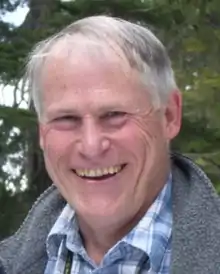Christopher Aikman
Christopher Aikman is a Canadian astrophysicist who spent most of his career (from 1968 to 2000) at the Dominion Astrophysical Observatory, National Research Council Canada in Saanich, British Columbia, Canada.
G Christopher L Aikman | |
|---|---|
 | |
| Born | November 11, 1943 |
| Nationality | Canadian |
| Known for | Secretary of Canadian Astronomical Society (1983-89) |
| Spouse(s) | Hendrika Marshall Aikman |
| Awards | Royal Astronomical Society of Canada Service Award (1983) |
| Scientific career | |
| Fields | Stellar compositions, asteroids & comets |
| 7840 Hendrika | October 5, 1994 | [2][3] |
| 10870 Gwendolen | September 25, 1996 | [4][5] |
| 24899 Dominiona | January 14, 1997 | [6][7] |
| 246913 Slocum | September 23, 1998 | [8] |
Early life and education
An early interest in astronomy led Aikman to join the Royal Astronomical Society of Canada Quebec Centre in 1958, at the age of 15.
He received a B.Sc. from Bishop's University in 1965 and a M.Sc. from the University of Toronto in 1968. His thesis [9] was based on microwave surveys of selected emission nebulae in the northern Milky Way made with the 46-m radio telescope of the Algonquin Radio Observatory, including the emission nebula IC1795.[10] This revealed what is perhaps the youngest stellar object in the Galaxy, namely W3(OH), a cocoon star [11] invisible at optical wavelengths but surrounded by a rapidly expanding ultracompact HII region, all within a dense obscuring dust shell. W3(OH) had previously been located in 1966 as the source of the first radio-identified astrophysical maser.
Career
In 1968 he joined the staff of the Dominion Astrophysical Observatory as scientific assistant to the Director.[12] His initial research was on the spectroscopy of comets, and of chemically peculiar stars whose surface compositions differ markedly from that of the Sun, with the aim of understanding the origin of their anomalies. This led to the discovery of a chemically peculiar star, HR 7775, having extraordinary enhancements of the element gold in its atmosphere.
From 1991, he conducted a program of tracking Earth approaching asteroids with the historic telescope built by John S. Plaskett, but the project was cancelled in 1997.
He was the Canadian representative on the Spaceguard Foundation, a group concerned with assessing the asteroid impact threat to Earth. An incidental product of this research was the discovery of four asteroids between 1994 and 1998 (as credited by the Minor Planet Center).[1]
References
- "Minor Planet Discoverers (by number)". Minor Planet Center. 24 February 2016. Retrieved 19 March 2016.
- Schmadel, Lutz D. (2007). "(7840) Hendrika". Dictionary of Minor Planet Names – (7840) Hendrika. Springer Berlin Heidelberg. p. 618. doi:10.1007/978-3-540-29925-7_6700. ISBN 978-3-540-00238-3.
- "7840 Hendrika (1994 TL3)". Minor Planet Center. Retrieved 19 March 2016.
- Schmadel, Lutz D. (2007). "(10870) Gwendolen". Dictionary of Minor Planet Names – (10870) Gwendolen. Springer Berlin Heidelberg. p. 747. doi:10.1007/978-3-540-29925-7_8151. ISBN 978-3-540-00238-3.
- "10870 Gwendolen (1996 SY4)". Minor Planet Center. Retrieved 19 March 2016.
- Schmadel, Lutz D. (2007). "(24899) Dominiona". Dictionary of Minor Planet Names – (24899) Dominiona. Springer Berlin Heidelberg. p. 875. doi:10.1007/978-3-540-29925-7_9790. ISBN 978-3-540-00238-3.
- "24899 Dominiona (1997 AU17)". Minor Planet Center. Retrieved 19 March 2016.
- "246913 Slocum (1998 SU63)". Minor Planet Center. Retrieved 19 March 2016.
- "U of Toronto Astronomy Department Theses 1930–1996".
- "IC 1795".
- Davidson, Kris (1970). "Development of a Cocoon Star". Astrophysics and Space Science. 6 (3): 422–435. Bibcode:1970Ap&SS...6..422D. doi:10.1007/BF00653862.
- "Christopher Aikman | RASC". www.rasc.ca. Retrieved 2018-10-17.
Selected publications
- Aikman, G.C.; Macrae, Donald A. (1968). "Radio Components of IC 1795". Astronomical Journal. 73: S1. Bibcode:1968AJS....73S...1A.
- Aikman, G.C.L; Balfour, W.; Tatum, J. B. (1974). "The Cyanogen Bands of Comet Bennett 1970 II". Icarus. 21 (3): 303–316. Bibcode:1974Icar...21..303A. doi:10.1016/0019-1035(74)90045-1.
- Aikman, G.C.L; Goldberg, B.A. (1974). "The Orbit and Nature of θ2 Orionis A". Journal of the Royal Astronomical Society of Canada. 68: 205–212. Bibcode:1974JRASC..68..205A.
- Cowley, C. R.; Aikman, G.C.L. (1975). "Nuclear and nonnuclear abundance patterns in the manganese stars". Astrophysical Journal. 196: 521–524. Bibcode:1975ApJ...196..521C. doi:10.1086/153432.
- Aikman, G.C. (1976). "The spectroscopic binary characteristics of the mercury-manganese stars". Publications of the DAO. 14: 379–410. Bibcode:1976PDAO...14..379A.
- Cowley, C.R.; Cowley, A.P.; Aikman, G.C.L.; Crosswhite, H.M. (1977). "Element identifications in Przybylski's star". Astrophysical Journal. 216: 37–41. Bibcode:1977ApJ...216...37C. doi:10.1086/155440.
- Aikman, G.C.L.; Cowley, C.R.; Crosswhite, H.M. (1979). "Dysprosium III lines in the spectra of peculiar A and B stars". Astrophysical Journal. 232: 812–818. Bibcode:1979ApJ...232..812A. doi:10.1086/157342.
- Cowley, C.R.; Sears, R.L.; Aikman, G.C.L.; Sadakane, K. (1982). "Possible iron abundance variations among superficially normal A stars". Astrophysical Journal. 254: 191–195. Bibcode:1982ApJ...254..191C. doi:10.1016/0032-0633(94)90036-1.
- McFadzean, A.D.; Skillen, I.; Carr, D.M.; Aikman, G.C.L. (1986). "The triple system DM Persei". Monthly Notices of the RAS. 222: 167–187. Bibcode:1986MNRAS.222..167H. doi:10.1093/mnras/222.1.167.
- McFadzean, A.D.; Hilditch, R.W.; Hill, G.; Aikman, G.C.L.; Fisher, W.A. (1987). "The South Galactic Pole – Radial velocities of 157 O-F8 stars". Monthly Notices of the RAS. 224 (2): 393–402. Bibcode:1987MNRAS.224..393M. doi:10.1093/mnras/224.2.393.
- Aikman, G.C.L.; Younger, P.F.; Weichert, D.H. (1989). "The daylight fireball of January 20, 1988". Journal of the Royal Astronomical Society of Canada. 83: 232–249. Bibcode:1989JRASC..83..232A.
- Tatum, J.B.; Balam, D.D.; Aikman, G.C.L. (1994). "Astrometric recovery and follow-up of near-Earth asteroids". Planetary and Space Science. 42 (8): 611–621. Bibcode:1994P&SS...42..611T. doi:10.1016/0032-0633(94)90036-1.
- Aikman, G.C.L.; Hesser, J.E. (1989). "Annual Report of the Dominion Astrophysical Observatory, 1 Apr 1987 – 31 Mar 1988". Bulletin of the American Astronomical Society. 21 (1): 180–190. Bibcode:1989BAAS...21..180A.
- Aikman, G.C.L.; Hesser, J.E. (1998). "Annual Report of the Dominion Astrophysical Observatory, 1 Apr 1996 – 31 Mar 1997". Bulletin of the American Astronomical Society. 30 (1): 472–489. Bibcode:1998BAAS...30..472A.